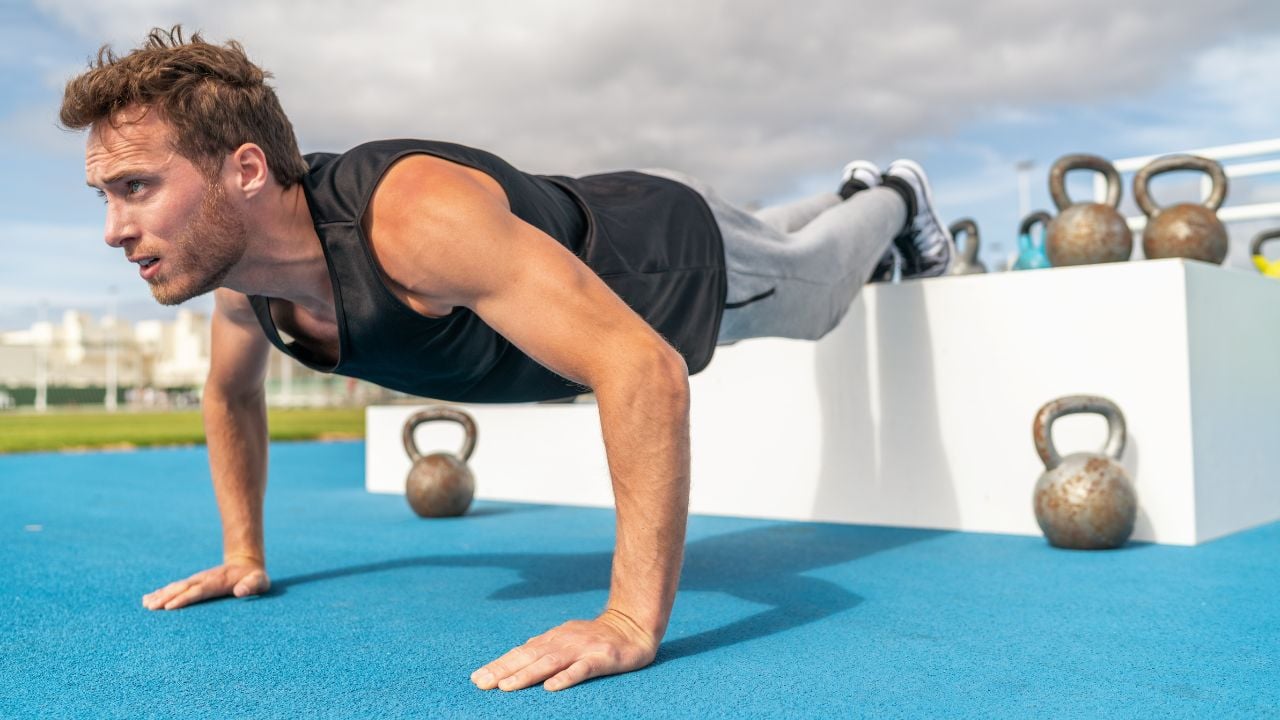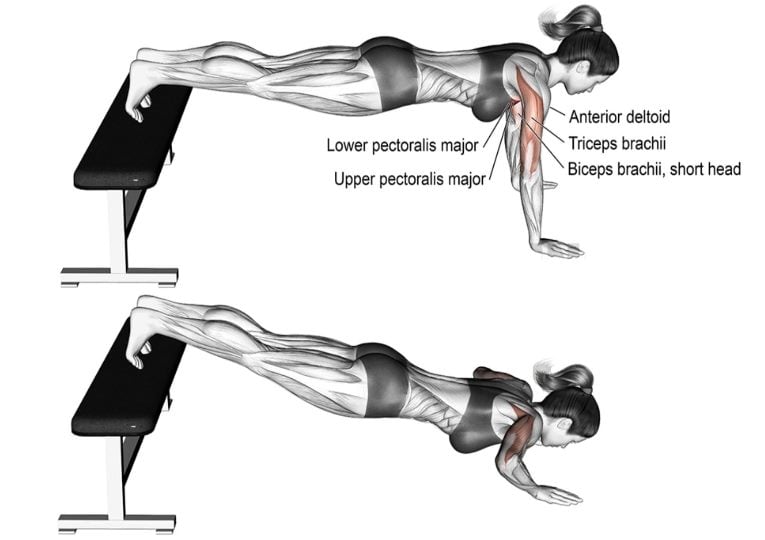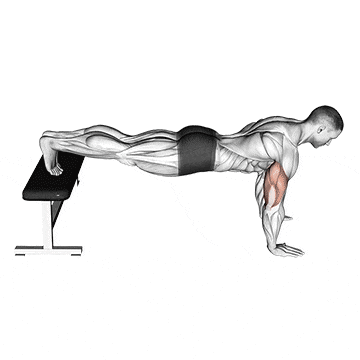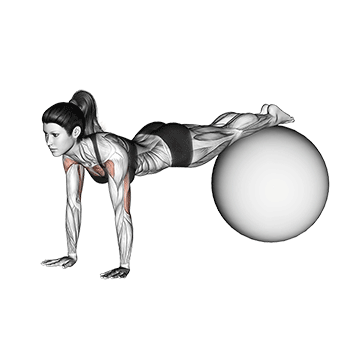Push-ups are a great way to strengthen your chest muscles and train your shoulder and triceps.
A decline push-up is a more challenging variation of a standard push-up. In this variation, you use a bench, step, or even a staircase to raise your feet higher than your hands.
In a regular push-up, you lift about 64% to 75% of your body weight. Elevating your feet increases the load on your upper body. With feet elevated to 30 cm, you press roughly 70% of your body weight; at 60 cm, it’s about 74%.
When you raise your feet, the movement’s focus moves up, putting more stress on the upper chest (clavicular head of the pectoralis major). The angle also recruits more anterior deltoids (front shoulder muscles) than a standard push-up.
The higher your feet, the greater the incline effect and the more the load shifts towards the shoulders.
It is ideal for intermediate and professional athletes who wish to enhance their upper body strength.
Know More: Push-Ups: How-To, Muscle Worked, Benefit, Variations

- Decline Push Up Muscles Worked
- How To Do Decline Push-Up
- Training Tips And Techniques
- Decline Push-Ups Modifications (Make It Easier Or Harder)
- 1. Stability Ball Push-Up Decline Push Up
- 2. Wall Decline Push Up
- FAQs
- Decline Push-Up Vs Standard Push-Up
- Do Decline Push Ups Work Upper Chest
- How The Decline Push Up Works The Upper Chest?
- Incline Push-Ups Vs Decline Push-Ups
- When To Perform The Decline Push Up
- References
Decline Push Up Muscles Worked
Depending on the degree to which you perform this exercise, it will be the muscles that are worked and with greater or lesser intensity. The main muscles involved in push-ups are:
- Primary Muscles (Major Movers): Upper Pectoralis Major (clavicular head), Anterior deltoids (shoulder muscle), and triceps.
- Secondary Muscles (Supporting Movers): Lower Pectoralis Major (sternal head), Serratus Anterior, Coracobrachialis
- Stabilizing Muscles (Postural Support): Rotator Cuff Muscles, Rhomboids & Mid-Trapezius and core muscles (abs, lumbar, gluteal, pelvic, and deep spinal muscles).

How To Do Decline Push-Up
- Ensure you have a stable bench or raised surface to hold your weight.
- Place your hands on the floor, slightly wider than shoulder-width apart. Your fingers should point forwards, or slightly outwards if that’s more comfortable for your wrists.
- Carefully, one foot at a time, place the tops of your feet (or your toes, if preferred) onto the elevated surface.
- Your hands should now be positioned roughly under your shoulders. Depending on the height of the platform, they might be slightly further forward to allow for a full range of motion.
- Tighten your core muscles to keep your body straight and stable. Avoid letting your hips sag or stick up in the air.
- Slowly lower your body by bending your elbows until your chest is an inch or two from the floor, or as far as your mobility allows while maintaining perfect form.
- Exhale forcefully as you push through the palms of your hands. Extend your elbows to drive your body back up to the starting position. Focus on squeezing your chest muscles as you push.
Training Tips And Techniques
- Keep your gaze slightly ahead on the floor, ensuring your neck is a natural extension of your spine. Avoid tucking your chin to your chest or craning your neck upwards.
- Keep your elbows tracking at about a 45-degree angle from your body. Avoid flaring them out to the sides (which stresses the shoulder joint) or tucking them completely against your torso (which shifts too much emphasis to the triceps).
- Maintain that rigid body line throughout – don’t let your hips sag or pike upwards.
- Begin with feet just 6-8 inches elevated and progressively increase height as technique and strength improve. I’ve found that mastering each height increment before progressing leads to better long-term results.
- As you lower (eccentric), allow your shoulder blades to retract (squeeze together slightly). As you push up (concentric), actively protract your shoulder blades. Full scapular movement ensures a full range of motion for your pecs and engages the serratus anterior.
- For the decline push-ups, begin by performing 2–3 sets of 6–8 repetitions. As you build strength, add more reps and sets.
- Keep the downward angle at 30–45 degrees for proper stimulation of the upper chest muscles. If you want to increase the angle further, please avoid going beyond 60 degrees, as this will shift the focus to the anterior deltoid.

Decline Push-Ups Modifications (Make It Easier Or Harder)
If you want to make decline push-ups easier, place your feet on a less inclined surface. This version is suitable for everyone, as it reduces the percentage of body weight you need to lift.
To make decline pushups harder, increase the angle of inclination or do stability ball decline push-ups
You can change the decline pushups to fit your fitness level, likes, and goals.
1. Stability Ball Push-Up Decline Push Up
If you’re looking for a way to be more creative with your upper chest workout, try doing push-ups with your feet on a Swiss ball.
The unstable surface of the stability ball forces the upper chest muscles to work harder. The unstable surface of the ball also forces your entire core (abdominals, obliques, lower back, glutes, hip stabilizers) to work overtime to prevent you from wobbling and to maintain a rigid plank.
It is a progression of the decline push-up that targets the chest, shoulders, and triceps while engaging the core.

2. Wall Decline Push Up
The Wall Decline Push-Up (or Wall-Assisted Pike Push-Up) is your next step if you’ve mastered regular decline push-ups and are looking for a serious challenge that builds incredible shoulder, tricep, and upper chest strength.
The steep angle places a significant load on your deltoids (anterior and medial heads), building size and strength. Your triceps work overtime to extend your elbows against the increased resistance.
It is a progression towards Handstand Push-Ups.
FAQs
Decline Push-Up Vs Standard Push-Up
Standard Push-ups are a compound strength-training exercise that involves raising and lowering the body using the arms while facing down in a prone, horizontal position.
The classic push-up has survived the test of time and is the single most efficient exercise for simultaneously strengthening the chest, arms, deltoid, lower back, abs, and glutes.
Decline push-ups are harder than standard push-ups because of the angle at which the exercise has to be done. The decline position means that more of the upper chest, shoulder muscles, tricep worked.
Do Decline Push Ups Work Upper Chest
The decline push-up is one of the best push-ups for the upper chest. To complete it, you must decline at a certain angle. Declination helps target the upper chest muscles.
How The Decline Push Up Works The Upper Chest?
The decline push-up requires that you place your feet very high. When you are in a decline position, you put more weight on the clavicular (upper portion) head of the chest, which allows you to work the upper chest more intensely.
Incline Push-Ups Vs Decline Push-Ups
Incline pushups are easier than basic pushups, while decline pushups are harder.
Both variations work your chest, triceps, shoulders, and back muscles. However, the Incline Push Up works your lower chest and back more because of the angle.
On the other hand, the decline push-up works the upper chest and front shoulders more than the regular or incline variation.
Once you’ve mastered the incline and basic pushups, try the decline push-up. It is an excellent exercise for challenging your upper chest and shoulders.
When To Perform The Decline Push Up
These decline push-ups are a must-have for any chest-focused workout. Because of their simplicity and good resistance, you should do them at the end of the workout.
Also, do the other push-ups to build upper body strength and mass.
- Standard push-ups
- Incline push ups
- Narrow-grip push up
- Pike Ups
- Hindu push ups
References
- The Biomechanics of the Push-up: https://www.researchgate.net/publication/271794661_The_Biomechanics_of_the_Push-up
- Ebben WP, Wurm B, Vanderzanden TL, et al. Kinetic analysis of several variations of push-ups. J Strength Cond Res 2011; 25: 2891–2894.
- Hollman JH, Stout JR. Comparison of Muscle-Activation Patterns During the Conventional Push-Up and Perfect· Pushup™ Exercises. The Journal of Strength and Conditioning Research. 2010 Dec;24(12):3352-62.
- Cogley RM, Archambault TA, Fibeger JF, Koverman MM. Comparison of muscle activation using various hand positions during the push-up exercise. Journal of strength and conditioning research. 2005 Aug 1;19(3):628.

Manish is a NASM-certified fitness and nutrition coach with over 10 years of experience in weight lifting and fat loss fitness coaching. He specializes in gym-based training and has a lot of knowledge about exercise, lifting technique, biomechanics, and more.
Through “Fit Life Regime,” he generously shares the insights he’s gained over a decade in the field. His goal is to equip others with the knowledge to start their own fitness journey.
